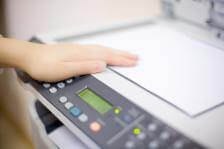Scanning and Archiving Your Papers
How to archive your paper by scanning it into your computer.

Kim writes in:
I hate storing paper. It might be better to scan financial documents and other records and keep them on the computer. What are the pros and cons? What things do I have to keep as paper?
I hate storing paper, too, but remember: the more clutter you have, the more filing cabinets you have to buy to store it, and thus the more you’re supporting the economy. But if you truly want to know how to shirk this important civic duty, I can help.
First of all, feel free to scan everything. Anything that you’re saving only for yourself can go straight into your computer. Things like those old love notes your teenage snuggle-bunny sent you, or the bad poetry you wrote in response can be taken out of physical form. In fact, you might be doing the world a service.
Keep legal documents in paper

Also keep anything you’ll have to show someone as proof. Think: identification stuff. Drivers licenses, passports, insurance cards, birth certificates, and that letter signed by the president giving you special wartime powers. Those are all worth keeping.
One clue is whether a document is printed on special paper or has some kind of seal of authenticity. Hold it up to the light. Is there a watermark? If so, look closer. If the watermark is actually the map to long-buried pirate treasure, handed down from your great Aunt Ethel, then by all means, keep the original! In fact, send it to me for safekeeping.
Anything with a hologram is probably also worth keeping, especially if it’s a hologram of a public figure in an embarrassing position. You never know when you may need leverage.
Check IRS publication 583
I checked with the IRS and their publication 583, page 15 is a gold mine. It has a chart showing how long you need to keep records for your taxes. On the very same page, it also says you can keep electronic images of books and records, as long as your recordkeeping system complies with Revenue Procedure 97-22. Unfortunately, I wasn’t able to find a copy of Revenue Procedure 97-22, so I can’t be more specific. You can find a link to the IRS web site in this episode’s transcript.
Make Sure to Keep Backups
If you scan your records, make sure you keep backups. My musician friend Jackie is depressed after losing seven years worth of music she’d created but never backed up. Ouch! But on the bright side, she sings the blues, so depression is a professional asset.
Your computer almost certainly can write CDs or DVDs. Back up your scanned files, label the backup discs, and store them someplace safe where you’ll remember them. The labeling and storing are important. Scanned tax documents safely stored in safe deposit box, filing cabinet, or fire safe — good. Scanned tax documents in hands of identity thief who finds the unlabeled CD laying in a pile in the corner at your tri-annual Vaseline, black light, Twinkies, and beer party — bad.
Name Your Scanned Files Carefully
Speaking of bad, can you imagine going to your scanned files and seeing filenames like, “Scanned bank form one,” “Scanned bank form two?” Neither can I. Which is how I know you’ll use good, descriptive names, like, “Scanned receipts for all New Orleans expenses, including the voodoo consultation.” Dot doc.
Scan in a Universal Format
Software changes as quickly as the positions of a politician who’s trailing in the polls. Make sure to scan your documents into a basic image format or a format that’s designed to stick around for at least seven years. PDF files are my format of choice, though you can use GIF or JPEG files as well. Make sure you’re scanning in a format that is likely to be in use even if your specific scanning software is no longer on the market. I even include a copy of Acrobat Reader on my scanned archives, so I can be sure I’ll be able to view the files. Er, assuming the operating systems are still compatible.
I’ve found scanning at 200 dots per inch gives me good resolution and doesn’t make the scanned files too large. But for small type or documents where the resolution matters, I use 300 dots per inch. When scanning pictures, I like to use grayscale. I only scan color when it’s absolutely needed.
So check out IRS publication 583 and rev up your scanner. This just might be a way to streamline your office. And you can rest easily knowing your papers are safe, and there really is a good use for your scanner other than drunken games of “can you tell whose body part this picture is?”
This is Stever Robbins. Email questions to getitdone@quickanddirtytips.comcreate new email .
Work Less, Do More, and have a Great Life!
RESOURCES:
- IRS publication 583 – 62-scanning-in-your-important-documents

